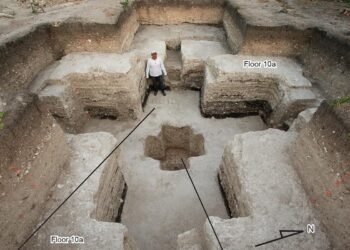Archaeologists have made an extraordinary discovery in the Valley of Stones National Nature Reserve, Dorset, England, during a community heritage project. A unique stone artifact, a polishing boulder known as a polissoir, dating back over 5,000 years, has been found in situ.
It features a distinctively glossy, dished surface that indicates its use for polishing stone axe heads during the Neolithic period. This remarkable find is only the second undisturbed polissoir ever found in its original position in England.
The polissoir, made from sarsen stone, a hard form of sandstone known as silcrete, was used extensively during the Neolithic period for constructing structures like Stonehenge.
Although sarsen boulders are found across southern England, the majority of the approximately 1,000 examined by experts were not used for polishing stone tools, making this discovery particularly exceptional.

The excavation project was led by the community archaeology company, Past Participate CIC, as part of a Dorset Area of Outstanding Natural Beauty initiative funded by the Farming in Protected Landscapes Fund.
The discovery was made possible by volunteers from the conservation group EuCAN, who, while working with Natural England, uncovered sarsens hidden by vegetation in the Valley of Stones.
Stone axe heads were essential tools for the Neolithic farming communities. They served for clearing woodlands, building houses, and creating monuments. Made from materials like flint, volcanic tuff, and granite, these axes were sometimes traded across regions or carried by their owners from distant quarries where the stones were sourced.
Although the actual wooden handles of the axes rarely survived, the polissoir discovery sheds light on the importance of these tools for ancient societies.
Following the discovery, an excavation and analysis of the surrounding area took place to find any possible traces of the individuals who created the stone axes.
Historic England has now commenced a comprehensive research program to study the wide landscape and gain a deeper understanding of the prehistoric and historic features that remain.
Jim Rylatt, director of archaeology at Past Participate CIC, expressed his surprise at the find, acknowledging its significance for Neolithic people. The polissoir’s location near an ancient routeway suggests it was a site frequented by people for polishing axes.
Anne Teather, another director at Past Participate, emphasized the value of community heritage projects and thanked the Farming in Protected Landscapes scheme, Historic England, and local landowners for their support.
Sasha Chapman, inspector of ancient monuments at Historic England, remarked that the rare discovery in this historic landscape provides an opportunity to explore the stone’s use and gain insights into the ancient communities that utilized it.
The boulder, once lost among the stones of Dorset’s Valley of Stones, has now unveiled its hidden historical significance, offering researchers valuable clues about the Neolithic period and the lives of ancient societies.























